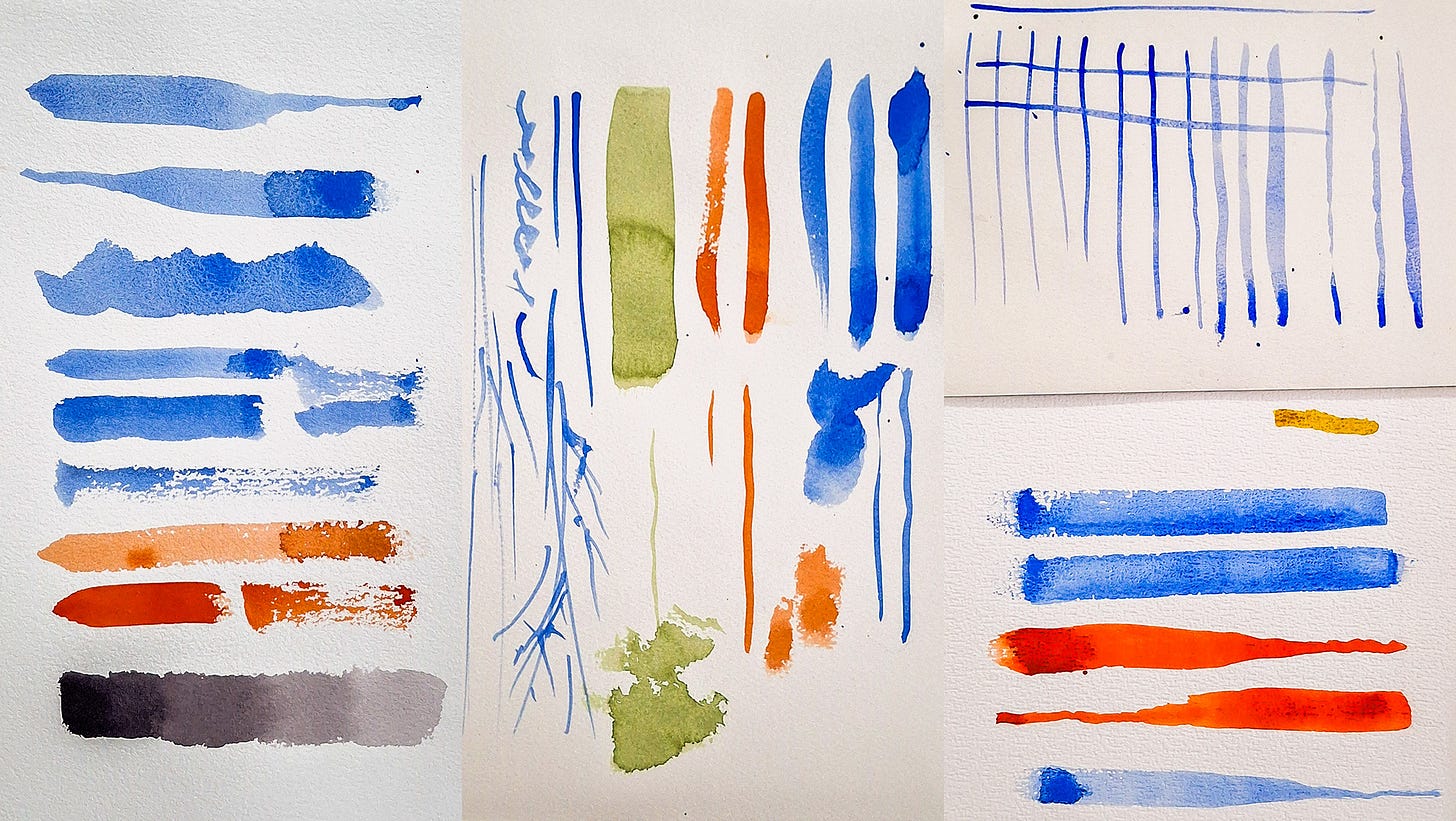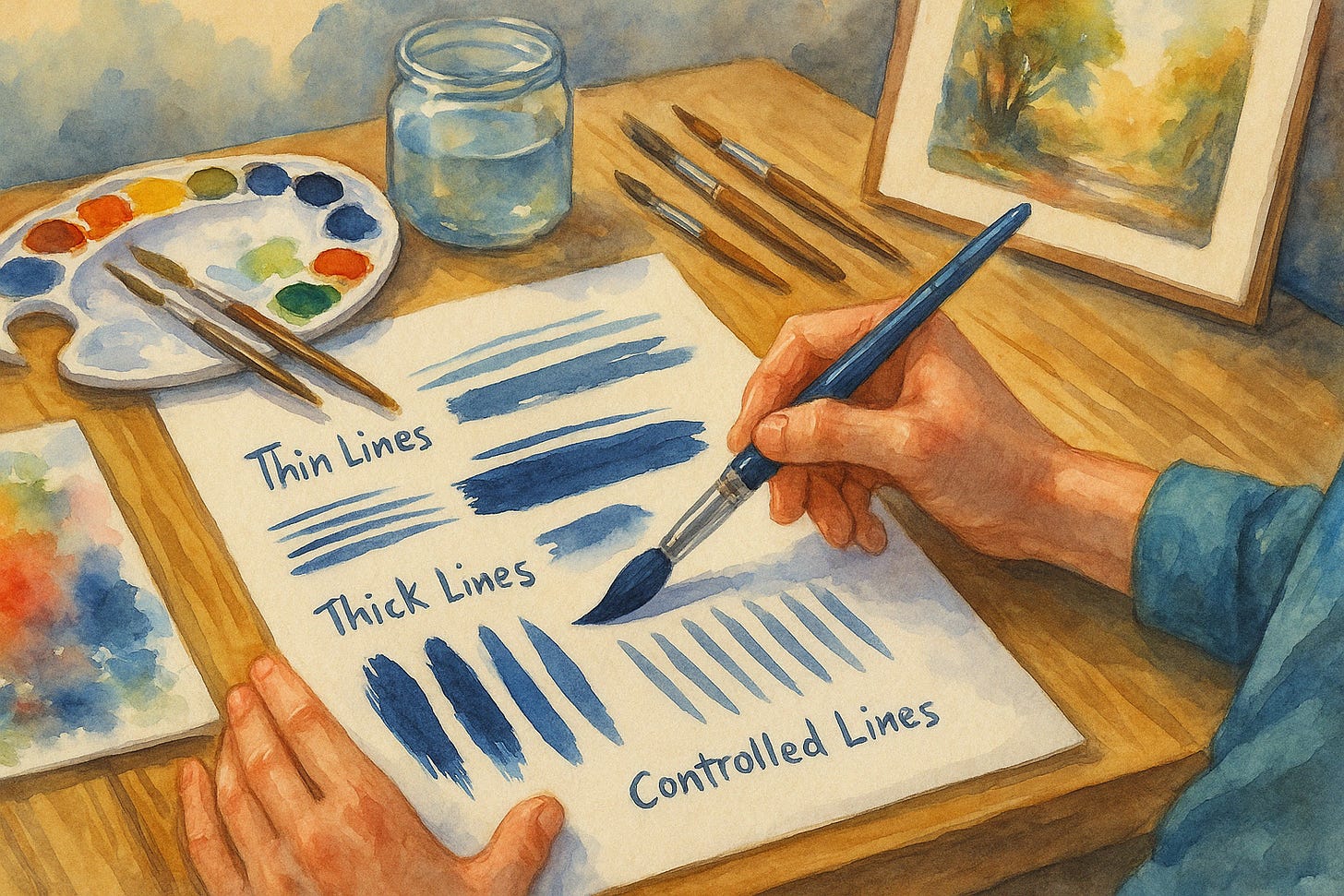Understanding Brush Strokes: Thin, Thick, and Controlled Lines in Watercolor
Master the Movement of the Brush to Create Expressive, Elegant, and Impactful Painting
Watercolour isn’t just about pigment and water—it’s about movement. The way your brush touches the paper, the pressure you apply, and the angle you hold it at all translate into the unique visual language of brushstrokes.
Understanding how to create thin, thick, and controlled lines gives you the power to:
✔ Add elegance and variety
✔ Define form with purpose
✔ Evoke texture, rhythm, and emotion
✔ Bring personality and life into every corner of your painting
In this post, let’s explore the essential brushstroke vocabulary, how to practice and master each type, and when to use them in your watercolour compositions.
1. The Anatomy of a Brushstroke
Before we talk about thickness and control, let’s understand what makes up a brushstroke:
Pressure: More pressure = thicker strokes; less pressure = finer lines
Angle: A vertical angle gives precision, while a flatter angle spreads the bristles
Water Load: Wet brushes create fluid lines; drier brushes give more texture
Brush Type: Round brushes are versatile; flat brushes give broad strokes; rigger brushes are designed for fine lines
💡 Brushstrokes are not just marks—they’re the artist’s fingerprint on paper.
2. Thin Strokes: Precision and Grace
🎯 Characteristics:
Sharp, delicate, hairline lines
Often used for fine details, grasses, branches, facial features, or outlining
🖌️ Best Tools:
Rigger or liner brushes
Tip of a well-pointed round brush
Fine-tipped travel brushes
✅ Tips to Create Thin Strokes:
Use the tip only, with very light pressure
Load the brush with pigment—not too watery
Hold the brush closer to the tip for more control
🎨 Use Thin Strokes For:
Grass blades, fur, fine veins in leaves
Outlining details in florals or buildings
Adding line variation in mixed media or ink & wash
💡 Thin lines can create elegance and intimacy—use them to lead the viewer’s eye.
3. Thick Strokes: Strength and Statement
🎯 Characteristics:
Bold, expressive, weighty marks
Used to create contrast, fill larger areas, or make dramatic accents
🖌️ Best Tools:
Flat brushes, mop brushes, or large rounds
A fully loaded round brush pressed with confidence
✅ Tips to Create Thick Strokes:
Use more pressure and a loaded brush
Let the bristles spread and allow for slight unpredictability
Move your hand from the shoulder, not just the wrist
🎨 Use Thick Strokes For:
Loose florals, landscapes, sky washes
Tree trunks, rock formations, and distant buildings
Background shapes in abstract compositions
💡 Thick strokes command attention—use them to express power and emotion.
4. Controlled Lines: The Balance of Art and Intention
🎯 Characteristics:
Even, deliberate, purposeful strokes
Neither too thick nor too thin, but with clarity and consistency
🖌️ Best Tools:
Round brush (Size 6–10)
Flat or filbert brushes for smoother edges
✅ Tips to Create Controlled Strokes:
Practice with a consistent water and pigment ratio
Maintain a steady hand and even speed
Use your entire arm for stability (elbow off the table helps!)
🎨 Use Controlled Strokes For:
Architectural forms, building edges, and patterned textures
Still life elements like pottery, fruits, or furniture
Creating rhythm and unity in compositions
💡 Controlled lines help anchor the painting—use them to organise and structure your scene.
5. Practising Brush Stroke Control
🖋 Warm-up Exercise:
Fill a page with alternating lines: thick → thin → thick → thin
Use one brush and change only the pressure
Focus on control and variation
🎨 Practice Strokes:
Long vertical strokes (bamboo stalks)
Short calligraphic strokes (florals, leaves)
C- and S-shaped strokes for petals and waves
💡 Think of this as brush calligraphy—every stroke has rhythm and flow.
6. Combining Brushstrokes for Visual Harmony
True watercolour mastery lies in variation and contrast. Use:
✔ Thin lines for detail and lightness
✔ Thick strokes for emphasis and impact
✔ Controlled lines for structure and balance
🎨 Example: In a landscape, use
Thin strokes for grass or distant branches
Thick strokes for tree trunks or foreground rocks
Controlled lines for architectural elements or paths
💡 Think like a composer—your brushstrokes are notes. Vary them for harmony and rhythm.
Final Thoughts: The Brush Is Your Voice
Brush control is about more than just technique. It’s about learning to speak through your art.
When you master thin, thick, and controlled strokes, you’ll notice:
✔ Your confidence improves
✔ Your painting speed increases
✔ Your visual storytelling becomes clearer
✔ Your artwork gains character and distinction
Don’t underestimate the power of brushstrokes—they are the unsung heroes of expression in watercolour.
🎨 Call to Action: Join My Watercolour Mastery Community!
Want to build fluency with your brush and develop your unique painting voice?
Join my Watercolour Mastery Community, where I’ll guide you through:
✅ Brushstroke techniques for every subject
✅ Layering, line variation, and expressive detail
✅ Personalised feedback and supportive coaching
✅ Live demos, tutorials, and themed challenges
📩 Subscribe to my blog today for new lessons, resources, and early access to upcoming watercolour training programs.
✨ Let your brush dance with intention—one graceful stroke at a time. 🎨🖌️




